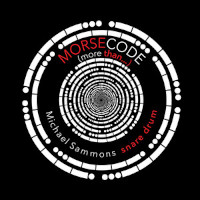Review by Colin Clarke
MORSE CODE (MORE THAN ... ) • Michael Sammons (snare dr); Keith Carrick 1 (mmb); Jason Nicholson 1 (vib); Danny Soulier 1 (timp); Viktor Valkov (pn 2 , elec 3 ) • EQUILIBRIUM 174 (48:16)
MÁSSON Prím. 1 IQ. CHRISTOPHER BRADFORD 2 Perpetual Motion (Marches, Trains and Light). NOZNY 3 Iris. CHAD FLOYD Without a Murmur. JASON NICHOLSON Canyon Suite. MELLITS Drag Queen
A whole disc of snare drum music might be a bit of a stretch for many, but Michael Sammons is an expert performer, and certainly having “guest” artists helps a lot. It is with solo snare drum that the disc begins, however: Áskell Másson’s Prím, written in 1984 and based on the first 15 prime numbers, which generate a rhythmic sequence. There is some variety of timbre, and there is no doubting Sammons’s expertise. Extended silences seem charged thanks to the drummer’s vitality. Massón is an Icelandic composer, born in 1953; I notice that he has written a Concerto for Snare Drum and Orchestra, which has been recorded by Evelyn Glennie, the Luxembourg PO, and Bramwell Tovey. It was described by my colleague Benjamin Pernick in Fanfare 29:4 as “neo-Romantic.” It might be difficult to pick up that aspect here, but one has to admire the rigor of the composer and the dedication of the performer.
There is a visceral change of texture to more Impressionist territories in Christopher Bradford’s Perpetual Motion (Marches, Trains and Light). The piano’s repeated pedaled arpeggios are set against the more objective activities of the snare drum, in a sort of manic commentary rather than a mere juxtaposition. Written in 2024 and commissioned for this album (as are all pieces except for Prím), this is young man’s music in its energy, and Bradford clearly is knowledgeable about percussion (his other works include at least two marimba quartets). Bradford waits until quite far into the piece before introducing the piano’s bass, a winning strategy; the work ends with a composed fade. Viktor Valkov is clearly a sensitive, intelligent pianist.
Contrasts are obviously the name of the game here. After the eminently pleasant sounds throughout of the Bradford comes the grungy, explosive sounds of Brian Nozny’s Iris. This is a fascinating piece for snare drum and electronics. Born in 1977, Nozny is a percussionist himself, currently also teaching at the University of South Alabama. Here, he plays with the military/martial associations of the snare drum while bringing in hints of popular musics, in a heady mix.
Born in 1977, Chad Floyd is Professor of Percussion at the University of Campbellsville. Written in 2021, Without a Murmur is exciting and imaginative. The piece was premiered by Nick Montoya of Utah University, a student of Sammons, in 2022. The “murmur” of the title is created throughout via the use of a superball (a toy bouncy ball made of rubber). The drum itself is indicated to be played with lz/hot rods, brushes, and sticks. If it all sounds gimmicky, it is not. The use of the ball is a valid compositional element—indeed, a vital one to the piece’s success—and the rhythmic energy is palpable throughout. There is also notable timbral variety.
There are three movements (without given titles on the disc) to Jason Nicholson’s Canyon Suite. The piece is based on the composer’s own love of hiking, including through many canyons, which possibly explains the sense of vividness that the music projects in Sammons’s sterling performance. Two snare drums are used in the performance: one concert snare in normal position, and one drumset snare (wire snares only) placed upside down on a stand. The idea of marching (as in marching through the canyon, perhaps) appears in the second movement particularly. The finale is urgent and virtuosic, and all credit is due to Sammons for his clear musical command.
But music is also about fun, and Marc Mellits’s Drag Queen is certainly that. Anyone who composes a piece called Tight Sweater is fine by me (see my review in Fanfare 47:1); the 2022 piece Drag Queen is high-octane, virtuoso stuff clearly relished by Sammons. It would make a great encore. Finally there comes another piece by Másson, IQ for snare drum, marimba, vibraphone, and timpani. After the restraint in the numbers of performers in the previous pieces, this feels like a full orchestra. Parts of Másson’s piece sound like modern jazz, while at others the snare drum seems to think it is in a Nelsen symphony. The contrast between the softer marimba and vibraphone, and the harsher snare drum and timpani, is explored in some detail by Másson, and there is a clear sense of resonance between the four players. It is fascinating when the snare drum is foregrounded, with the pitched instruments reactive to the soloist’s virtuosity.
The recording is exemplary. This is a fascinating sonic journey; really, it is a percussion-based adventure. There are no booklet notes or annotations, but Sammons’s own website provides useful links to the relevant composers’ websites. Recommended. Colin Clarke






















